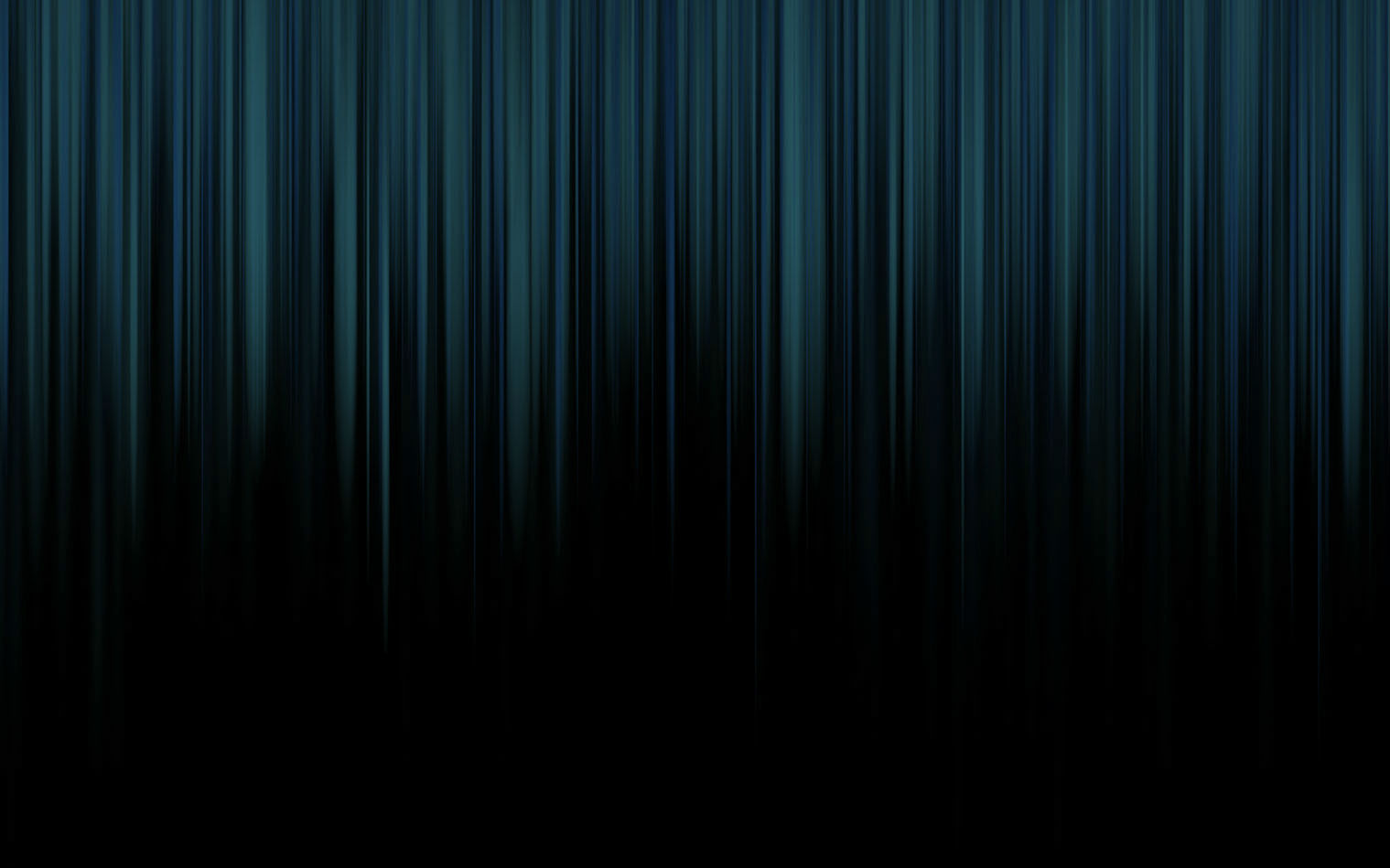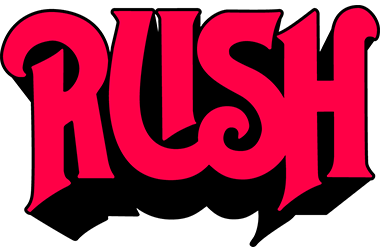News, Weather, and Sports Archive
December 2006 Entry
"At the Gate of the Year..."
When I was little, I used to admire a framed piece of needlepoint work that hung on my grandmother’s wall. She had made it on the family farm in Southern Ontario during the dark days of World War II, her needle weaving the colored threads with precise, artful stitches into a field of white linen. In one corner, a brown-robed arm raised a golden lantern, and beside it meticulously sewn letters traced out a few lines of poetry that had been quoted by Britain’s King George VI in a December, 1939, radio address.
It began, “I said to the man who stood at the Gate of the Year, ‘Give me a light that I may tread safely into the unknown.’”
That image and those words have stayed with me all my life, especially the idea of the “Gate of the Year” as a time for reflection and resolution. Right now I have no idea what’s going to happen in 2007, or if I will “tread safely into the unknown,” but 2006 has been quite a year to look back upon. (I am reminded that exactly twenty years ago, I sat down at the Gate of the Year and made a list entitled, “Why 1986 Was the Greatest Year.” Nice to think that even then I knew enough to count my blessings—and now I know it even better.)
Exactly one year ago (to recap a story begun in earlier reports), my bandmates and I started talking about working on some new songs. Alex and Geddy got together in Geddy’s home studio in Toronto and simply played, letting the new ideas flow out unguided and unedited, while 3000 miles away in California, I began drafting some lyrics and sending them up.
In March, the three of us met at my house in Quebec, and Alex and Geddy played me the six songs they had been working on. All of us felt very positive about their direction, and agreed that we needed to spend some time working together. In May we moved into a small Toronto studio, and started refining those songs and writing a few others.
As previously reported, in June I recorded three songs in Los Angeles with my friend Matt Scannell, and for me as a drummer, that was a challenging and inspiring experience. Also, the new set of purpose-built “recording” drums that my friends at Drum Workshop put together for me, which were intended to be used on Matt’s project and become my “West Coast kit,” sounded so good that I had them sent straight east, to use on the new Rush album.
Later that month, I also fulfilled a longtime challenge as a motorcyclist, doing a “Thousand-in-One”—1000 miles in one day—in the course of riding my R1200GS from Los Angeles to Quebec, 3000 miles, in four days. (Yes, I was in a hurry!)
Though obviously no leisure tour, it was still a powerful traveling experience, giving me what felt like a “snapshot panorama” of a wide swath of North America—California, Nevada, Arizona, Utah, Colorado, Nebraska, Iowa, Illinois, Wisconsin, Michigan, Ontario, and Quebec—in such a brief time.
And even on that express route, mainly keeping to the “mileage disposal units” of the interstates, and even in the fierce heat of early summer in the desert Southwest, there were still hours of sublime beauty: the Mojave Desert (always), I-70 through Utah and Colorado (perhaps the most scenic stretch of interstate in the country), and even the Great Plains. Unlike some travelers, I never find that part of the country boring. The highways are flat and straight, sure, but those endless green farmlands all around make a nice kind of “intermission” in a transcontinental roadshow, opening with the deserts and mountains of the West, and closing with the forests and rocky bluffs of upper Michigan and northern Ontario. On a journey like that, the prairies were a welcome pastoral interlude.
Des Moines seemed to be hosting a big vintage tractor event, and I liked seeing all the flatbed trucks and trailers in the opposite lanes carrying shiny old International, John Deere, Allis-Chalmers, Case, Ford, Massey-Ferguson, and Minneapolis-Moline tractors, and even a few massive old combines freshly restored. (You can take the boy out of the barn and the farm equipment dealership, but . . . )
In September, Alex and Geddy and I started working together in Toronto once more, feeling good about the songs we had put together back in May, but determined to do even better. The work seemed to come easier then, too, when we were feeling confident and committed, and we soon assembled a few more songs we all liked.
In the past, we had always found it immeasurably valuable to bring in a coproducer, someone who could help us be objective about our work, and—perhaps more importantly—to push us a little farther in songwriting, arranging, and performing. This time, we put out feelers for possible collaborators, listened to the work of several candidates, and began contacting the ones we thought most promising.
Meanwhile, a certain young producer and engineer in California heard we were working on new material, and asked his manager to contact our office, and send us some of his work. His name—Nick Raskulinecz—remained unspellable and unpronounceable for a while, but we liked what we heard.
Nick was best known for his highly successful work with the Foo Fighters, but before that he had a long history as a musician, engineer, and producer. He had started out in Knoxville, Tennessee, and more-or-less worked his way west, studio by studio. When we met Nick, we all liked his youthful, unbridled enthusiasm, but at 36, he was also experienced enough to have a strong background in music and recording. We agreed with the comments and suggestions he had for our new songs, and loved his excitement about them, so we signed him up.
By October, Toronto’s days were often chilly, damp, and gloomy, with cold rains and occasional spells of glittering autumn sunshine, darkening earlier every day. Nick joined us in the little studio down by the old waterfront, and together we continued refining the arrangements and our individual parts. We had ten songs finished by then, and were working on one of our typical “mental-instrumentals” to be the eleventh. Nick was an irrepressible air drummer, and he would describe his suggestions for my drum parts with wild flailing arms and vocalizations: “bloppida-bloppida-batu-batu-whirrrrr-blop—booujze.”
That last syllable is onomatopoeic for a combination of bass drum and crash cymbal (of course), and before long it became Nick’s, er, “nick”name: “Booujze.” (There was considerable discussion over its proper spelling.)
We also recruited master engineer Rich Chycki, who had worked with Alex on the mixes for the R30 DVD, and (we thought) captured our best-ever live recording. So, adding in Lorne (Gump) Wheaton and Russ Ryan to look after the equipment, we had a great team in place by November, when we moved to Allaire Studios in New York’s Catskill Mountains to start the “serious” recording.
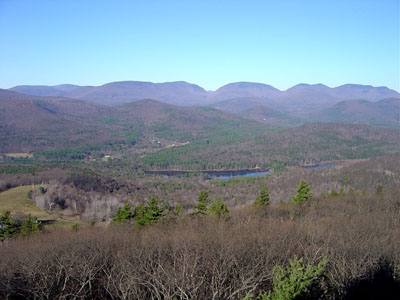 |
| View near Allaire Studios in the Catskill Mountains of New York |
This is the view from what was originally the summer estate of a wealthy Pittsburgh family. The rambling Adirondack-style country house of wood and stone was built in 1920 at the top of a mountain, looking north to this long valley, meandering river, and distant, rounded peaks. To the east the view opened on the wide Hudson Valley.
One sunny November morning, Gump, our visiting photographer, Andrew, and I walked through the woods to a quaint old wooden lookout tower. We stood above the brown and green forested humps stretching far into the distance, the sky of blue glass reflected in the shining lake just below (Ashokan Reservoir, part of New York City’s water system), and I shared some of the local natural history I had learned.
(Unlucky friends. And readers. I am reminded of when my brother Danny gave our mother all of his journals to read, and she reported, “They are good . . . for when I have trouble sleeping.” Recently Mom and Dad got broadband service, and I wrote Mom that now she might find similar relief in my book reviews.)
Still, natural science can be more interesting, more dramatic,when you’re looking right at something, and learning to understand what you see. All around Gump, Andrew, and me, those low, glacier-scrubbed mountains looked the same as the Appalachian chain to the north and south—some of the oldest mountains on Earth—but the Catskills were considered “geologically unrelated.” In fact, that humped landscape was not made of “mountains” at all, but the isolated remnants of a high plateau of sedimentary rock—like the mesas of the Southwest, only clothed in soil and trees. Over millions of years, layers of ancient sea bed and river deltas had blended with alluvial material from the immense Acadian range to the east, once as tall and sharp-edged as the Himalayas. Those mighty mountains had crumbled into a plateau which itself rose as high as 10,000 feet, then compacted into layers of sandstone and shale, while water continued to erode the softer sediments away.
And if that scope of geological time wasn’t dizzying enough, geologists theorized that those mountains were at least the third range to have risen and crumbled there over the eons. It makes the little moments that seem so important to us, like the Gate of the Year, seem so brief. As they are.
Twenty years ago, I wrote about such feelings in “Time Stand Still,” and ten years later, again in “Dog Years.”
I’d rather be a tortoise from Galápagos
Or a span of geological time
Than be living in these dog years . . .
Pointing up into that translucent sky, I said to Gump and Andrew, “Imagine during the last Ice Age, the ice might have been something like a mile thick here.”
That ice sheet had gradually melted more than 10,000 years ago, and the turbulent flow of meltwater had carved the majestic Hudson Valley. Among the bare, young trees around us (none appeared more than about fifty years old, evidence of the history of repeated logging throughout the East) and the evergreens clustered in sheltered, damp groves, you could see the huge boulders, “erratic blocks,” that had been dropped as the glaciers receded.
By then Gump and Andrew were nodding off (incidentally, “Rip van Winkle” was set in the Catskills), so we walked back through the woods to the present day.
The buildings of the baronial Glen Tonche estate had been adapted around two state-of-the-art residential studios, in the most secluded and splendid of surroundings. The property still enclosed fifty wooded acres, and the single-lane driveway seemed to loop its way up the mountain (mesa) for miles. One misty afternoon, Gump, Russ, and I watched from the studio windows as a doe and two yearling fawns browsed across the slope of brown leaves below. The property manager, Colby, told us he had been seeing a lot of black bears that autumn, searching for food before their long hibernation.
So it seemed the nearby village of Bearsville came by its name honestly. Back in January of 1996 (in fact, during the “Blizzard of ’96”), we had recorded Test for Echo at Bearsville Studios (now closed, unfortunately). In the summer of 2005, I spent a few days at Allaire shooting my Anatomy of a Drum Solo DVD, and I had simply loved the place, despite the near-constant fog and rain obscuring the view.
Indoors, the big attraction was the recording room (once the estate’s “Great Hall”), a vast, almost church-like space of wood floor, galleries, and lofty beams, two huge stone fireplaces, and washes of glorious natural light from tall windows. It was a wonderful acoustic environment for drums, plus the accommodations were cozy and comfortable, and the food was great, so I went out on a limb and recommended Allaire to the other guys—hoping they would like it as much as I had.
Well, they did. It was like the old days of working at Le Studio in Quebec, the late ’70s and ’80s, when we would retreat to an isolated place in the country—where there was little to do but work—and immerse ourselves in music-making, and just hanging out together. (Volleyball was the sport back then, but we didn’t really have time for any sports this time—unless you count eating and drinking well. We do.)
Rich and Nick consulted on how best to mic up my drumset for that big room, including the careful placement of some vintage microphones Nick had shipped from his own L.A. studio. Late on the first night after everyone arrived, Lorne and Russ had to throw together some amps for an impromptu jam session with the three of us and Nick (Booujze wasn’t just an incredible air musician—he could play some fiery rhythm guitar for real, too).
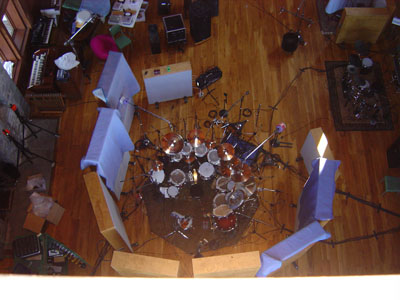 |
All of the songs were mapped out in rough form by then, each of our parts developed and refined back in Toronto. However, any traveler knows that having a map is not the same as riding the road. Now we had to deliver performances as perfect, powerful, and musical as we could, because now they would be permanent. The first job was recording new drum and bass parts over those demos—and of course, trying to “beat” them. (My judgment of a recorded performance: “Can I beat it?” For a while I can, and when I can’t, I know I’m done.)
The Mighty Booujze came into his own there, coaxing, coaching, and inspiring me into ever more outrageous drum parts and fills. “Bloppida-bloppida-batu-batu-whirrrrr-blop—booujze.” Sweaty and sore, I would come into the control room to listen to a playback, and hear myself thrashing away at the very edge of my abilities, just barely pulling it off (or not), and I would have to laugh out loud at the audacity—and the excitement, if it worked.
Geddy was listening, too, and he shook his head slowly and smiled, saying, “Now that’s comedy!”
In turn, Booujze also urged Geddy’s bass playing into uncharted areas, playing along with him on “air bass” as he described his ideas. Geddy and I soon decided we were “the world’s funniest rhythm section,” and thought we ought to call the album Don’t Try This at Home.
Earlier, back in Toronto, we had been working on a complex, syncopated section in one of the songs—a part that had taken me hours to learn—and Nick turned to me and said, “Do you think you could solo over that?”
Ha—what a question! Of course I could solo over it—I’d love to!—but I would never dare to suggest such a thing myself. When Nick pushed me like that, he would say, “Hey man, I wouldn’t ask if I didn’t know you could do it,” and of course that was a kind of challenge. All of us picked up that “can do” spirit, and it came to express the mood of our sessions at Allaire—brash, confident, determined, inspired, challenged, fired-up, defiant, excited.
As I said to Rich and Nick when my last drum track was finished, “I have never enjoyed the recording process so much, nor been so satisfied with the results.”
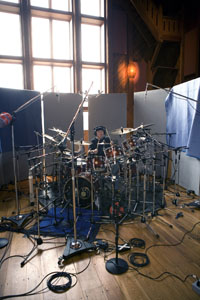 |
| Photograph by Andrew MacNaughtan |
And when those final bass and drum tracks were done, and the two weeks we had booked there were over—the other guys simply stayed. With two separate recording rooms available at Allaire, Alex worked on his guitar tracks and overdubs with Rich in one room, while Geddy and Booujze worked on vocals in the other.
I hated to leave then, but I had already made plans and commitments. Like Robert Frost in one of my favorite poems, “Stopping By Woods on a Snowy Evening,” I had “promises to keep.” (Lately I have been thinking about Robert Frost’s epitaph, “I Had a Lover’s Quarrel With the World,” because it echoes the point-of-view of some of my lyrics for the new songs. A couple of times I deliberately used the conventions of the typical “relationship song” to express my “lover’s quarrel”—not with a single person, but with a whole bunch of people who were so foolish as to disagree with me.)
Anyway, by the original plan, after our two weeks at Allaire, Alex and Geddy were supposed to return to Toronto and work on guitars and vocals at home. I hadn’t minded the idea of missing that, but it was different to have to leave Allaire after such a happy, productive time, knowing I would be missing out on the excitement and camaraderie we had created in that wonderful place. (I’m going back next week.)
The important thing is that all of that energy, excitement, and activity have sped the project along, and now it looks as though the recording will be finished by the end of the year—far ahead of schedule. We are planning on doing the final mixing early in the New Year, but have made no commitments beyond that. No doubt our manager, Ray, has plans of his own, but we simply haven’t gotten to that yet. We all know by now that you can’t take anything for granted, or be truly sure what’s going to happen—in news, weather, or sports.
“I said to the man who stood at the Gate of the Year, ‘Give me a light that I may tread safely into the unknown.’”
Well, as they would say out East, “there ain’t no such of a light,” but like most other people in this crazy mixed-up world, we will carry on as if there were.
“Bloppida-bloppida-batu-batu-whirrrrr-blop—booujze.”
-| Click HERE for the main News, Weather, and Sports Archive Page |-
-| Click HERE for more Rush Biographies and Articles |-

